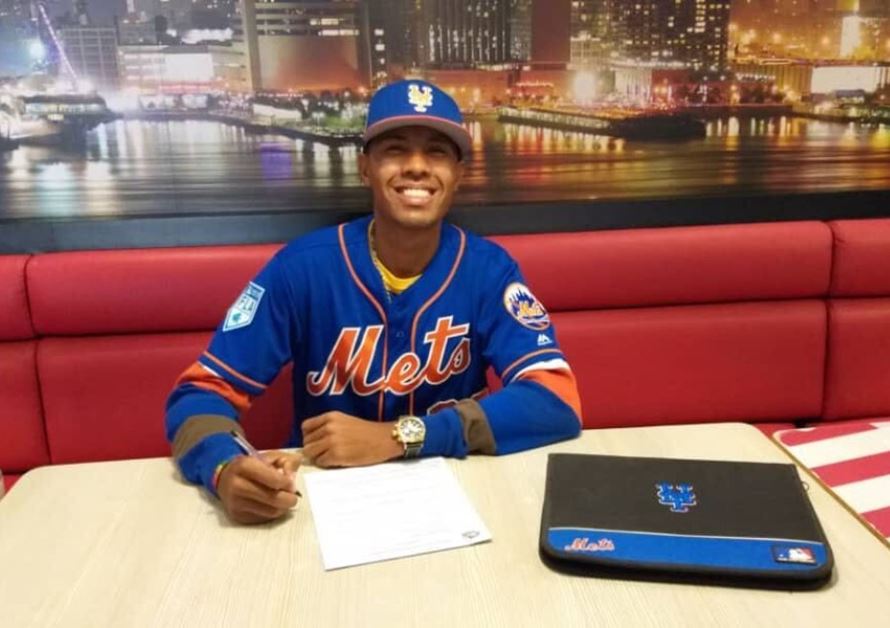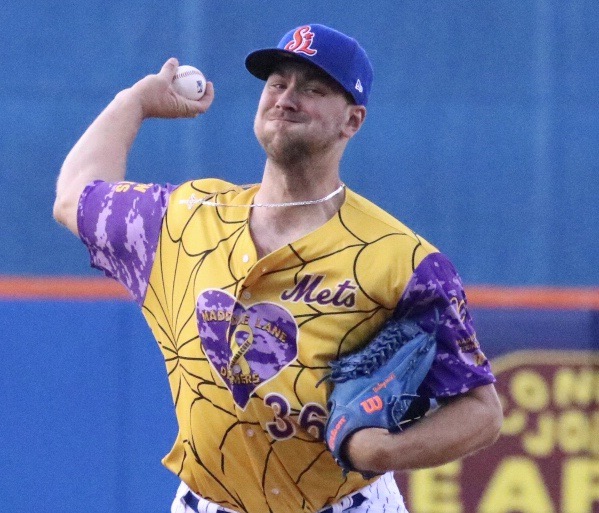
Richard Brito (Photo: Baseball America)
A common theme that will be present throughout our 2021 prospect write-ups is going to be a lack of, or less, new information than we are used to having at this point of the year. It bears mentioning that with a lack of a 2020 minor league season, we don’t have as much video, game footage, scouting reports, and the like.
Nevertheless, we here at Mets Minors have spent countless hours debating amongst one another regarding what information we do have to get to the conclusions that we have drawn.
30. Yennsy Diaz, RHP
B/T: R/R Age: 24 (11/15/1996)
Height: 6’1 Weight: 202
Acquired: Acquired from Toronto Blue Jays in exchange for Steven Matz (1/27/21)
ETA: 2021 Previous Rank: N/A
2019 Stats: (AA) 144.1 IP, 3.74 ERA, 3.93 FIP, 1.23 WHIP, 3.30 BB/9, 7.23 K/9
Yennsy Diaz missed the entirety of the 2020 regular season with what was described as a “severe lat strain,” but continued pitching in the Dominican Winter League for the Estrellas Orientales. While he posted up a 4.91 ERA over just 3.2 innings there, what one should be looking for is whether or not the can return to form after such an injury. Prior to his injury, Diaz’ fastball sat 94-98 MPH, and he was able to dial it back to 94-97 this winter.
Despite the fact that Diaz has been a career starter in the minor leagues, the consensus on him is that he is destined for the bullpen. Diaz is a three pitch pitcher working with the aforementioned fastball, a low-90’s change-up, and mid-70’s curveball. Despite Diaz’ fastball being seen as his only plus pitch, Eric Longenhagen of FanGraphs opines that Diaz’ time as a starter has helped develop his change-up into his best secondary pitch, that has some sinking/tailing action.
A move to the bullpen could potentially help Diaz’ rates, which as they stand right now, are not setting the world afire. Being able to throw harder consistently would enable Diaz to change looks more often against hitters, perhaps playing up his secondary pitches. However, he will have to find a bit more control in his fastball, as it tends to ride away from him, and can tend to ride high as well.
29. Jordany Ventura, RHP
B/T: R/R Age: 20 (11/30/2000)
Height: 6’0 Weight: 160
Acquired: Signed as International Free Agent by New York Mets (7/25/2018)
ETA: 2024 Previous Rank: N/A
2019 Stats: (3 levels) 52.1 IP, 3.78 ERA, 3.81 FIP, 1.09 WHIP, 3.27 BB/9, 9.29 K/9
Jordany Ventura had an exciting 2019 season that saw him make his way through three different minor league levels, including a late season playoff push for the Appalachian League’s Kingsport Mets. Ventura spent most of his season with the Gulf Coast Mets, where he was about two years younger than the rest of the leagues pitchers (average of 20.3 years of age).
Not being the largest pitcher, Ventura makes up for it with an athletic build, and is still growing into his frame. Ventura was a low bonus signing in 2018, getting $20,000. What has emerged since then is a control pitcher, with a simple motion. Baseball Savant notes that Ventura has a low-90’s fastball with natural cutting action, as well as an above average slider, and a tumbling change-up.
Where Ventura will be placed among the minors ranks will give us an indication of where the Mets think he is in his development, particularly with the recent cutting of several leagues across the minors. As it stands, his current projection is that of a back of the rotation starter.

Photo by Ed Delany, MMN
28. Tylor Megill, RHP
B/T: R/R Age: 25 (3/2/1995)
Height: 6’7″ Weight: 230
Acquired: Drafted in the 8th round; 6th pick (230 overall) in the 2018 MLB Draft
ETA: 2022 Previous Rank: N/A
2019 Stats: (A/A+/AA) 71.2 IP, 3.52 ERA, 2.26 FIP, 1.24 WHIP, 3.14 BB/9, 11.55 K/9
Drafted out of the University of Arizona, Megill didn’t exactly light up the stat sheets. Megill had a higher ERA and allowed more contact than one would want from a guy who mostly relieved. You may then ask, “then why did the Mets draft him?” Simply put, the Mets organization believed in what they saw, and there was plenty to see.
Standing at a towering 6′ 7″ Megill has that tall solidly built frame that scouts often look for. Additionally, he had a very smooth, repeatable delivery from a high three-quarter slot started off with a high leg kick, and without many kinks on the way down. Beyond just his frame, he was a statcast darling, as his mid-90’s fastball also featured higher than average spin rates. That which is evidenced by the amount of tail in the pitch itself. While his slider may be a more average offering, it flashes above average when effective. Megill also had a change-up that was a more recent offering at the time of the draft.
Currently, Megill has a fairly undefined role within the Mets organization. Out of college, Megill only started 11 out of 57 games played, including just one start in his senior year. After being drafted, Megill started two of his ten games played in Brooklyn. Later, in 2019, starting in class-A Columbia, he started just three of his fourteen games, but started every game after being promoted to advanced-A St. Lucie, and later double-A Binghamton. Throughout that time, Megill has been able to limit home runs, allowing just two during the 2019 season. Just as well, he’s been able to lower his WHIP from the 1.546 he had his senior year in Arizona. Most importantly, he’s continued to miss bats, and at a higher rate than he did in college.
All in all, Megill likely has a future in a relief role with the Mets. Despite that, he may still be seeing starts until when he comes up. Depending on which route the organization takes with him, his development may be quicker than originally expected. Don’t be surprised to see Megill in camp next spring, and even seeing some major league action in 2022.
27. Joshua Cornielly, RHP
B/T: R/R Age: 20 (01/15/2001)
Height: 6’2 Weight: 175
Acquired: Signed as International Free Agent by New York Mets (06/02/2018)
ETA: 2025 Previous Rank: N/A
2019 Stats: (DSL Mets/GCL Mets) 46.0 IP, 4.89 ERA, 2.91 FIP, 1.39 WHIP, 1.76 BB/9, 10.17 K/9
Signed as an international free agent in 2018, Cornielly had a reputation as a proper athlete on the mound. Showing what has been said to be an advanced feel for pitching helped Cornielly catch the interest of area scouts. Cornielly has a three pitch arsenal including a low 90’s fastball, an advanced change-up, and a breaking ball that, while needing some work, has good raw spin, but has not taken shape, according to FanGraphs.
Another trait Cornielly has a reputation for is being a consistent strike thrower. In 2019, Cornielly threw 84 percent of all pitches for strikes as well as held a 23 percent whiff rate (data acquired from baseball savant). On top of the excellent strike data, Cornielly also limited walks while walking just 4.5 percent of all hitters faced (just nine batters throughout the season). The unfortunate part of throwing so many strikes is that is also resulted in Cornielly 10.8 hits per nine innings pitched. Perhaps some of it could be attributed to having some younger, raw fielders playing behind him, given a .389 BABIP to pair with his .289 batting average against, as well as an unlikely 49.4 left of base percentage.
Cornielly will likely show improvements with the advent of some better fielders behind him, but the difference between his potential outcomes may come down to him filling out and increasing velocity, and/or picking up and solidifying another pitch. Right now, Cornielly seems to have the make-up of a back of the rotation starter, but his ceiling is a very fluid matter.
26. Richard Brito, RHP
B/T: R/R Age: 22 (11/05/1998)
Height: 6’4 Weight: 198
Acquired: Signed as International Free Agent by New York Mets (07/02/2020)
ETA: 2025 Previous Rank: N/A
2019 Stats: N/A
This is one of the places where the absence of a 2020 minor league campaign hits development in a strange way. The Venezuelan signed without much fanfare in the then 21-year-old’s video throwing fastballs 100 miles per hour. Without a doubt, the organization was excited to see him develop, and just how quickly that could happen, given that he was the age of the average college draftee when signed.
On top of Brito’s fastball, he has a notable slider that has considerable break. But, that isn’t the end of his arsenal, as his trainer, Norberto Rivas, has him working out a variety of pitches, including a sinker, cutter, splitter, curveball, and change-up. What pitches will stick will be a bit of a waiting game for us all.
Brito has a solid frame and has the physicality to remain a high-octane pitcher long-term. The question is, where will that fastball top out at, and what is his future role.
Rather than show you the 100-MPH video, we’ll put one up of his various breaking pitches. Watch for the curveballs at the end of the session.

